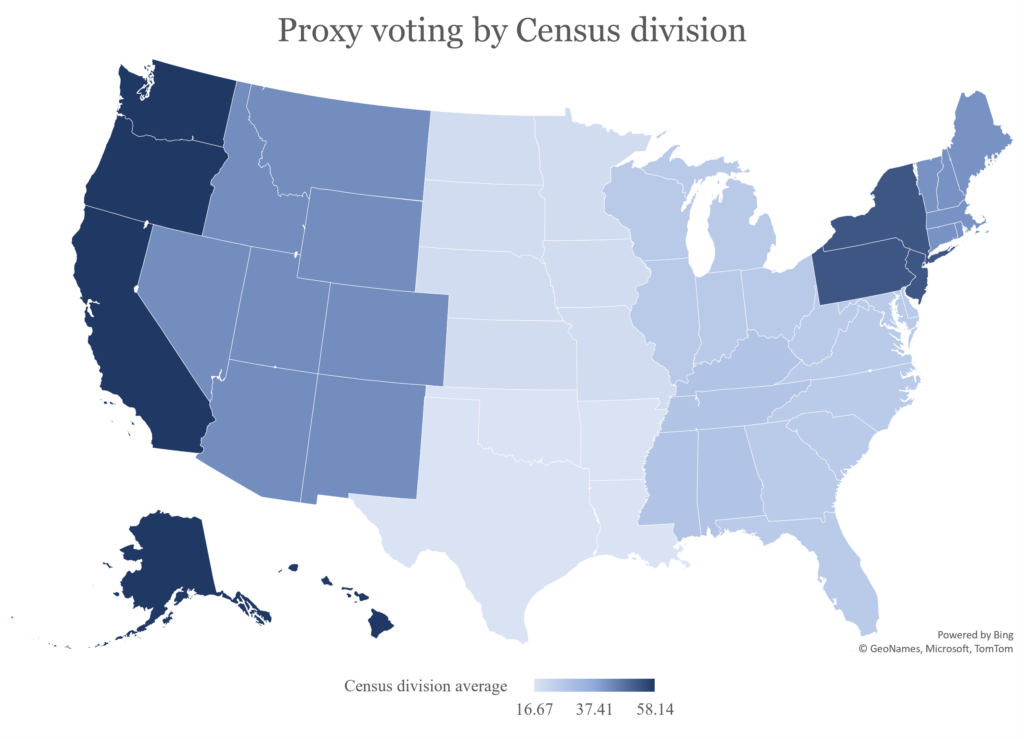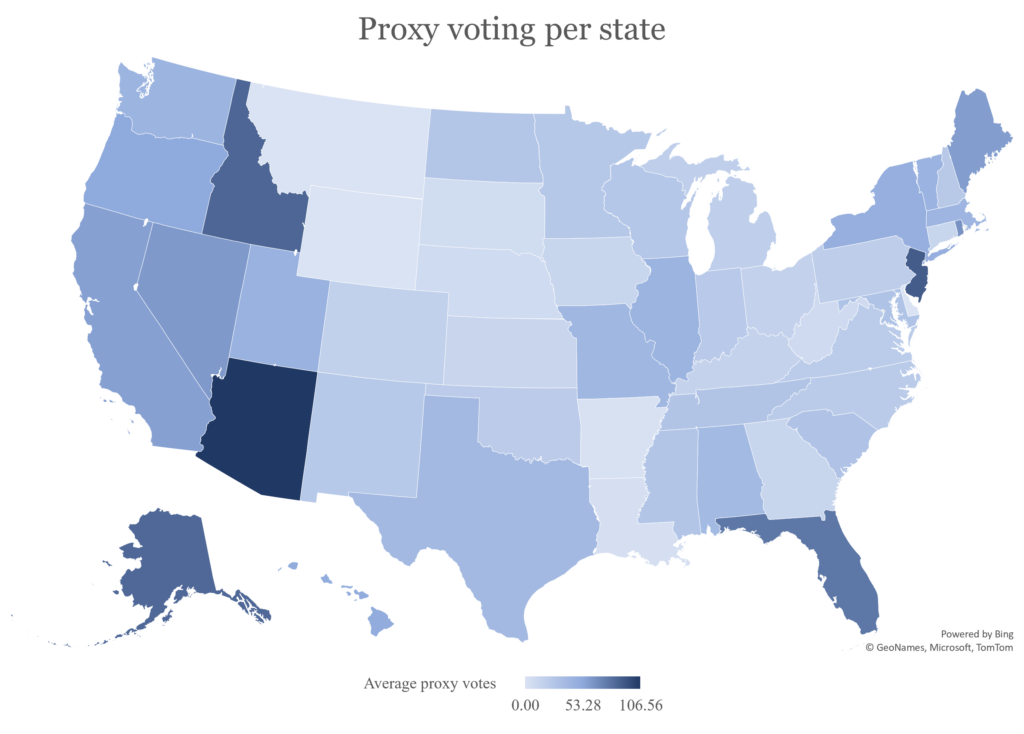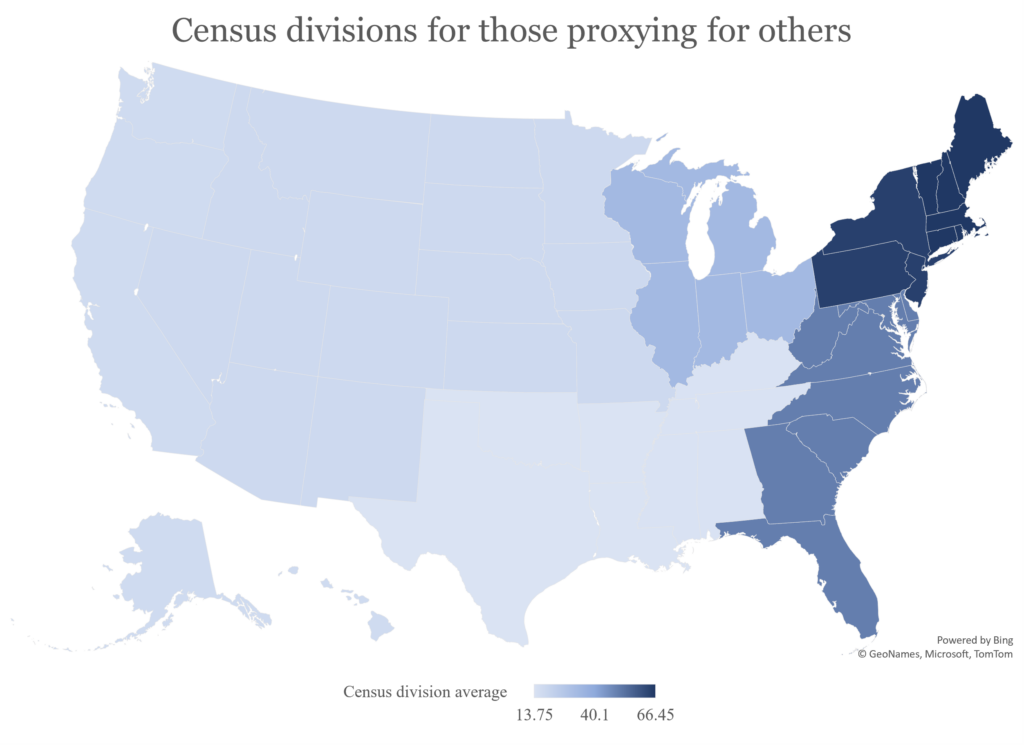
An accounting of all proxy votes cast during the first session of the 117th Congress and further insights
By STEPHEN JACKSON
WASHINGTON, DC — The first session of the 117th Congress opened with its first vote on January 3, 2021 and held its last vote just after midnight on December 15, 2021. In all, 449 Roll Call votes were called during 2021. Proxy voting was allowed for 438 of those votes.
As our previous piece analyzed proxy voting through Thanksgiving 2021, we wish to share the final statistics about proxy voting during the first session and some further insights we gleaned. To gather this data, we once again scraped all Roll Call votes from the House Clerk’s website and the proxy votes information from the corresponding PDFs.
Toplines from 1st session of 117th Congress
- During the 438 Roll Call votes where proxy voting was permitted, there were 185,171 total votes cast. Proxy votes accounted for 17,263 of those votes – which is 9.32% of all votes.
- Democrats cast 12,500 proxy votes – 72.41% of all proxy votes. – while Republicans cast 4,763 proxy votes – 27.59%.
[wpdatachart id=8]
- Of the 438 votes, each Democratic member voted by proxy on average 55.55 times – 12.68% of the time. Each Republican voted on average 22.15 times – 5.06% of the time.
- 339 of the 440 Members of Congress who served during the first session voted by proxy at least once.
- 202 Democrats voted by proxy out of 225 Democratic members who served at some point during the first session. Therefore 89.78% of all Democrats voted by proxy at least once in 2021.
[wpdatachart id=7]
- 137 Republicans voted by proxy out of 215 Republican members who served at some point in the first session. Therefore 63.72% of Republicans voted by proxy at least once during 2021.
[wpdatachart id=6]
Member voting by proxy during the 1st session of the 117th Congress
- A total of 101 Representatives did not vote by proxy – 78 Republicans and 23 Democrats.
- Only 65 Members of Congress did not participate in proxy voting at all – neither voting by proxy nor serving as a proxy for someone else – 57 Republicans and 9 Democrats.
[wpdatachart id=9]
The top 15 proxy voters list is similar to what we published last month, with the top 14 being the exact same, with only minor shuffling. The leaders, Reps. Frederica Wilson (D-FL-24), Al Lawson (D-FL-5) and Bobby Rush (D-IL-1), did not return to the House floor before the end of the year. On a more positive note, the rest of the top 15 appeared in person at least once. Ranging from Rep. Donald Payne, Jr. (D-NJ-10) casting a handful of in person votes to Rep. Ted Lieu (D-CA-33) voting in person during all the additional 63 Roll Call votes we analyzed.
[wpdatachart id=2]
Insights into who is casting proxy votes for whom
If you’ve watched C-SPAN at any point since May 2020, you already know the mechanics of proxy voting are different than regular voting in the House. Instead of simply vote electronically with your vote card, the person serving as the proxy gets floor recognition and announces who they are proxying for and how that person is voting.
The person who cast the most proxy votes for others was Rep. Don Beyer (D-VA-8), followed by Reps. Frank Pallone (D-NJ-6), Hakeem Jeffries (D-NY-8) and Katherine Clark (D-MA-5). Reps. Lou Correa (D-CA-46) and Jennifer Wexton (D-VA-10) also cast over 500 proxy votes for others.
[wpdatachart id=10]
Of those members, Reps. Don Beyer and Jennifer Wexton, who both represent Northern Virginia, make geographical sense due to their close proximity to Capitol Hill. However, Reps. Hakeem Jeffries and Katherine Clark standout as both are in Democratic leadership with Jeffries serving as Democratic Caucus Chairman and Clark is Assistant Speaker.
Not only do both cast a lot of proxy votes, they also cast a lot of proxy votes for a large number of colleagues. In fact, they lead all of Congress with Rep. Clark casting proxy votes for 28 different members and Rep. Jeffries casting proxy votes for 19 members.
[wpdatachart id=11]
On the other side of the coin, there are those members who used the largest number of different people as their proxy. Reps. Seth Moulton (D-MA-6) and Vern Buchanan (R-FL-16) tied for the most with 11 different members casting proxy votes for them.
[wpdatachart id=12]
Proxy voting rules do have some limits. Someone serving as a proxy may vote for up-to ten colleagues during a Roll Call vote. Reps. Katherine Clark and Frank Pallone voted for the maximum of ten Representatives during two Roll Call votes, 314 and 315.
Rep. Guy Reschenthaler (R-PA-14) voted for eight Members once during Roll Call vote 339. Rep. Don Beyer voted for eight members ten times – Roll Call votes 27, 28, 29, 30, 31, 445, 446, 447, 448, and 449. Rep. Katherine Clark voted for eight members twice – Roll Call votes 19 and 20.
Of the 438 Roll Call votes in which there was proxy voting, Rep. Dwight Evans (D-PA-3) cast a proxy vote for someone else during 418 of those votes while Rep. Jahana Hayes (D-CT-5) voted during 414 separate votes.
[wpdatachart id=23]
Reps. Evans and Hayes also proxy voted for the same person the greatest number of times. Unsurprisingly, many of the Members who voted by proxy the most tended to use the same person as their proxy for a large percentage of votes.
Proxy voters and their partners
[wpdatatable id=11]
In total, 260 Congressmen served as proxies for someone else – 59.09% of the Congress. 147 Democrats served as a proxy for someone else, which is 65.33% of their caucus. While 113 Republicans served as a proxy for someone else, which is 52.56% of their conference.
Relation between Member and their Proxy
When examining who is casting a proxy vote for whom, a couple of trends emerge. Over half the time, the Member of Congress is more senior than the person who is casting the proxy vote for them. About a quarter of the time, the person serving as the proxy is more senior than the person they are voting for. In total, 72.65% of votes are cast by someone whose seniority is less than or equal to the Member they are proxying for.
[wpdatachart id=20]
A relationship also exists between the states and regions they represent. Proxy partners are from the same state 43.76% of the time. And they’re from the same Census region 59.31% of the time.
[wpdatachart id=21]
[wpdatachart id=22]
Geography of those voting by proxy and those casting proxy votes
Unsurprisingly, distance plays a role in proxy voting. The effect of geography on the number of times a person votes by proxy is illustrated clearly when broken down by Census divisions.

In terms of state delegations which proxy voted the most, members from Arizona proxy voted on average 106.56 times – nearly 25% of the time.
[wpdatachart id=18]
On the other end of the spectrum, three of the seven Representatives who represent at-large districts did not vote by proxy at all. Their states, Delaware, Montana, and Wyoming, lead the way for states with the fewest proxy votes per member.
Proxy voting by state delegation

In terms of who is casting the proxy vote for others, one would be unsurprised to hear that those located closer to Washington, DC would cast more proxy votes for others than those located further away.

Virginia leads the way in average number of times a Member cast a proxy vote for another Member with 156.18 votes per Representative in its delegation.
[wpdatachart id=25]
Proxy votes cast for others by state
Retirements and Proxy Voting
Whether a Member of Congress is running for reelection also plays a part in proxy voting.
Average proxy usage for all Members of Congress is 39.23 votes. For those seeking reelection or who have not yet announced their plans in the House (as of 1/24/22, 393 Representatives) they averaged 36.33 proxy votes. For those seeking another office such as U.S. Senate, or as their state’s governor or attorney general, (15 Representatives), they averaged 36.53 proxy votes.
For those retiring and not running for anything at the end of the 117th Congress (25 Representatives), they averaged 91.12 proxy votes. That’s 20.80% of all votes. If you include missed votes, that average rises to 110.28, or 25.17% of all votes in which they were absent from the House floor.
[wpdatachart id=17]
Conclusion
The amount of proxy voting during each Roll Call vote stayed fairly flat throughout 2021.
[wpdatachart id=16]
There were some notable outlier votes towards the end of the year. Roll Call vote 315 on October 12 had 165 proxy votes – 38.19% – which is the record for most proxy votes. The last day of votes this session, November 14 into early November 15 saw about a third of all Members vote by proxy for Roll Call votes 441-449.
[wpdatachart id=13]
However, while total proxy voting remains largely flat, the ratio of Democrat proxy votes to Republican proxy votes decreased as the year went on.
As seen in the following chart, towards the end of the year, the first Roll Call votes occurred where Republicans out proxy voted Democrats – 11 such votes occurred out of the 438 votes in 2021. The trendline shows that Republicans are approaching parity in terms of proxy voting usage.
[wpdatachart id=15]
There are other insights which can be gleaned from the data. We’ve included it in CSV format.
One CSV contains all the Roll Call votes of the 1st session of the 117th Congress. In addition to information including date, Roll Call vote number, and vote total, it includes the number of proxy votes cast during each vote, broken down by party.
Another CSV contains summary data for each Representative. It includes the number of proxy votes they took, number of votes they didn’t vote in, and number of in person votes.
The final CSV contains all proxy votes taken during that session including the name of the Member, their district, party, and whoever proxy voted for them.
We’ve also included a chart below with the number of proxy votes taken by each Member of Congress in 2021.
Stephen Jackson is Director of Policy at The Ripon Society.
Proxy Voting during the 117th Congress
Proxy voting data from January 3 to December 31, 2021 — Roll Call votes 12-449.
Proxy voting was not implemented for Roll Call votes 1-11.
[wpdatatable id=6]
The Ripon Society is a public policy organization that was founded in 1962 and takes its name from the town where the Republican Party was born in 1854 – Ripon, Wisconsin. One of the main goals of The Ripon Society is to promote the ideas and principles that have made America great and contributed to the GOP’s success. These ideas include keeping our nation secure, keeping taxes low and having a federal government that is smaller, smarter and more accountable to the people.



